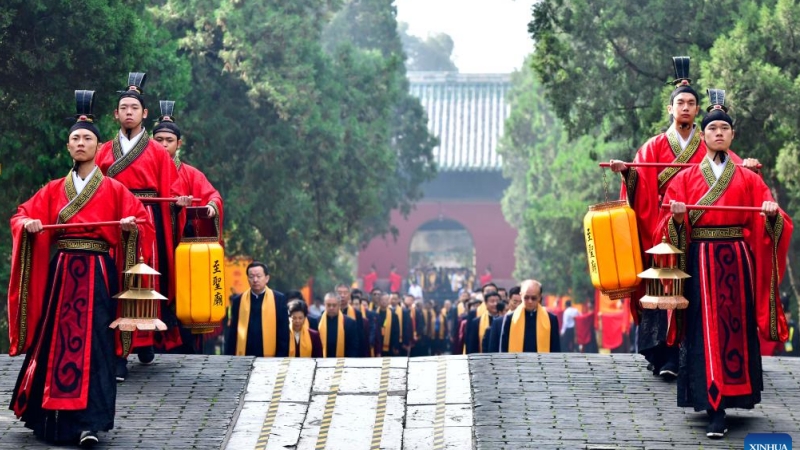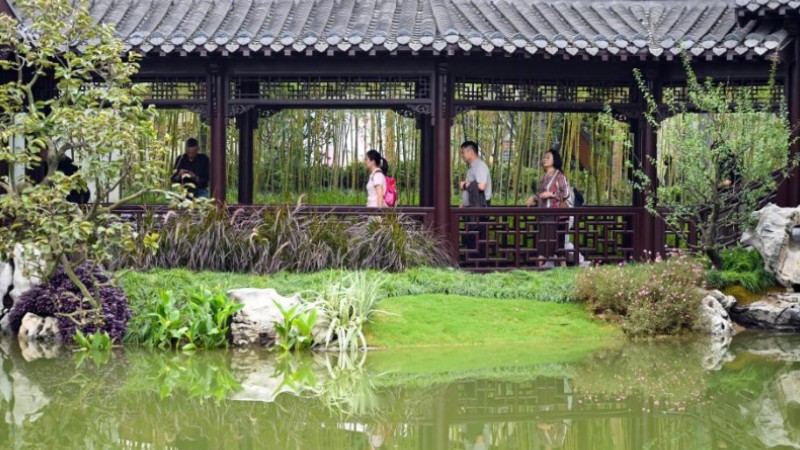Mt. Cho Oyu expedition conducive to Tibet's ecological protection

Members of a Chinese expedition team head for the summit of Mount Cho Oyu on Oct. 1, 2023. (Xinhua)
LHASA, Oct. 6 (Xinhua) -- A Chinese expedition team has been conducting research around Mount Cho Oyu since the end of September and reached its summit on Oct. 1, obtaining abundant scientific results that are thought to be conducive to the protection of the "roof of the world."
Located on the China-Nepal border, Mt. Cho Oyu is the sixth-highest mountain in the world, with an altitude of 8,201 meters.
"The mountain's Gyalpolha Glacier is one of the glaciers in the Himalayas with the greatest retreat," said Yao Tandong, an academician with the Chinese Academy of Sciences.
It is the best area to study the impact of glacier retreat on the structure and function changes of periglacial ecosystems, its carbon source and sink processes, as well as on the region's ecology, said Yao. The expedition team sampled and monitored methane and carbon dioxide in the air of six lakes near the Gyalpolha Glacier for the first time.
The summit of Mt. Cho Oyu is particularly wide and broad and similar to a football field, which is very rare among the highest peaks in the world. Preliminary research revealed that the peak ice layer is the thickest among the peaks above 8,000 meters, with a visual thickness of over 70 meters.
Yao said the snow and ice samples at the summit were collected for the first time to reveal the change process and mechanism of the "Asian water tower" cryosphere, which provides scientific support for the ecological protection of the Qinghai-Tibet Plateau.
"Compared with the small radar (less than half a meter in length) used during the expedition of Mount Qomolangma, a larger radar (over one meter in length) was used this time in order to better detect thicker ice on the summit of Mount Cho Oyu," said Yang Wei, a researcher from the Institute of Tibetan Plateau Research of Chinese Academy of Sciences.
Though human expedition to extremely high-altitude mountains is greatly limited, the expedition on the Qinghai-Tibet Plateau is necessary to protect the local environment, such as the most important and fragile "Asian water tower," and avoid disasters led by melting glaciers such as ice floods and avalanches, said Yang.
Yang recalled the two ice avalanches in the lower reaches of the Yarlung Zangbo River in October 2018, during which the glacial debris blocked the river, threatening the downstream areas.
The big elevation gap between the glaciers and the Yarlung Zangbo River resulted in the high possibility of ice avalanche, said Yang. He and his colleagues had spent a year conducting research, testing, and installing equipment and successfully achieved early warning of ice floods and avalanches in the area.
Five automatic weather stations have been set up at the altitudes of 4,950, 5,700, 6,450, 7,100, and 8,201 meters on Mt. Cho Oyu, and precipitation observation equipment was installed at the two lower stations. They can monitor the carbon dioxide in the air to record the situation and changes in the carbon sink.
Together with the Qomolangma-Shishapangma weather stations already established, this expanded meteorological observation network will help reveal more characteristics of climate change in this extremely high-altitude region, said researcher Zhao Huabiao, also from the Institute of Tibetan Plateau Research.
Since the launch of the second comprehensive scientific expedition to the Qinghai-Tibet Plateau in 2017, China's scientific research team has recorded a series of important signs of progress, which show that the total carbon sink of the entire Qinghai-Tibet Plateau is 120 to 140 million tonnes per year, and the carbon emissions are about 55 million tonnes per year, achieving a carbon surplus of over 65 million tonnes, said Yao.
"The entire Qinghai-Tibet Plateau has achieved carbon neutrality and will become increasingly significant to China's dual carbon goals with the overall ecological improvement," Yao added.
Photos
Related Stories
- County in E China's Anhui explores new ways to turn ecological resources into valuable assets
- More national parks urged to protect species
- China's globally shared wisdom in sand control a microcosm of ecological civilization construction: former Polish president
- Int'l ecological competitiveness forum opens in north China
- China celebrates achievements of its national parks
- Antelopes on road to safety
- Ecology project brings clear water, Asian Games to Zhejiang river
- Infographics: Explore China's national parks
- Building Beautiful China contributes to global environment governance
- A look at China's ecological progress
Copyright © 2023 People's Daily Online. All Rights Reserved.









